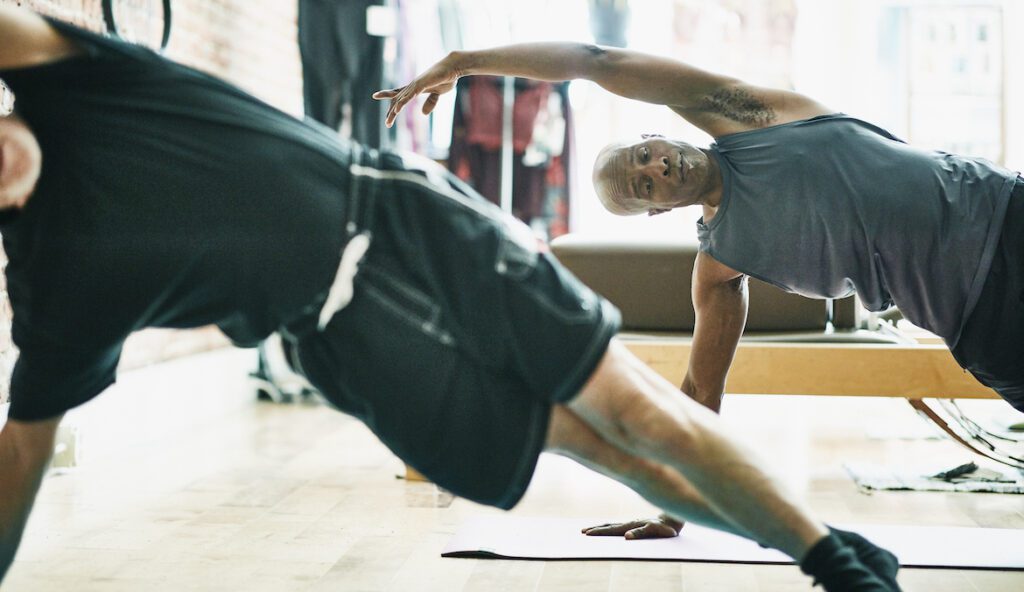For those passionate about Pilates, you’re likely familiar with the ideal athleisure, accessories, and self-care practices to enhance your sessions. Yet, you might not have discovered a specific type of breathwork that can elevate your practice and help you achieve a sense of grounding.
Introducing hypopressive breathing—a technique that emphasizes completely emptying your lungs. It resembles the uddiyana bandha in yoga, often referred to as an “abdominal lock.”
“This technique creates a vacuum effect in your thoracic, abdominal, and pelvic cavities by reducing pressure, resulting in a lift and toning of the pelvic floor,” explains Anouska Shenn, a certified Pilates instructor and the founder of The Office Yoga Company.
One important disclaimer: avoid breath-holding exercises during Pilates, as the practice emphasizes breathing in coordination with movement.
However, incorporating hypopressive breathing before, after, or independently from your Pilates routines can significantly enhance your practice.
What is hypopressive breathing?
Hypopressive breathing is a method where you completely empty your lungs and then maintain that state to create a vacuum effect. This practice serves as an essential exercise to improve pelvic floor health.
Imagine your abdomen as a closed pressure system. Whenever pressure changes—due to coughing, deep breaths, or physical effort—your abdominal structures must effectively manage that pressure. Pelvic floor exercises like hypopressive breathing help in this aspect.
“When our pressure management falters, gravity exerts downward pressure on the pelvic floor,” shares Blair Mauri, MS, OTR/L, a pelvic floor therapist and owner of Blair Mauri Pelvic Health. “Continual downward stress can weaken the pelvic floor and lead to excessive tension.”
Such tension can manifest in issues like incontinence, pelvic organ prolapse, painful intercourse, lower back pain, or chronic constipation. “Hypopressive breathing effectively optimizes pelvic floor function by naturally lifting these tissues without increasing tension,” Mauri mentions.
Enhancing your pelvic floor function can alleviate pelvic discomfort and lower back pain, boost oxygen and energy levels, aid digestion, and improve movement during your Pilates sessions.
A recent study found that an eight-week hypopressive exercise program significantly improved pelvic floor muscle strength and reduced urinary incontinence symptoms among women aged 18 to 60 experiencing pelvic floor dysfunction.
Additionally, hypopressive breathing optimizes lung function, which can further benefit your Pilates practice. “Increasing rib mobility is crucial for diaphragm function and maximizing your breath capacity,” notes Mauri.
How do you do it?
Begin by taking a few deep breaths to gauge where you notice pressure:
Is it concentrated in your chest or abdomen?
Are your ribs expanding as you inhale?
Ideally, you should experience movement in all these areas rather than just one. “Rib mobility is especially crucial for effective hypopressive technique, so you might need to focus on this aspect first,” Mauri advises. “Spend time retraining your breath to ensure that everything expands on the inhale and contracts on the exhale.”
Once you’re comfortable with that, you can progress to hypopressive breathing exercises by following these steps:
1.
Gently exhale as if you’re fogging up a window, ensuring no pressure is directed to your lower belly or pelvic floor.
2.
After exhaling, pinch your nose and close your mouth while “pretending” to inhale without actually taking in air. Visualize your ribs expanding, which will make your stomach appear concave.
3.
Hold this position for 3-5 seconds before inhaling.
How does it benefit your Pilates practice?
This breathing technique is a valuable addition to your Pilates routine. While you shouldn’t hold your breath during Pilates movements—since the practice encourages synchronizing breath with movement—hypopressive breathing can serve as an effective preliminary or concluding exercise.
“Hypopressive breathing is designed to be performed independently, but it can be incorporated at the beginning or end of your Pilates practice,” explains Shenn.
Strengthening the pelvic floor is already a fundamental aspect of Pilates. For example, a 12-week Pilates program focused on pelvic floor strengthening saw significant improvements in stress urinary incontinence symptoms among women aged 45 to 70, with benefits lasting for up to six months after the program completed.
“Hypopressive breathing effectively complements a Pilates routine, as it additionally retrains and strengthens the deep core along with the pelvic floor,” Mauri emphasizes.
A strong and well-coordinated deep core and pelvic floor provides enhanced stability during your Pilates practice and throughout daily activities.
“Our pelvic floor muscles function collaboratively with our deep core muscles to stabilize the spine, supporting posture and providing a solid foundation for all movements,” says Shenn.
Tips to get started
As you introduce hypopressive breathing into your Pilates regimen, Shenn suggests keeping the following tips in mind:
Start with 1-3 sets of 3 repetitions, allowing for rests between sets.
If you’re a beginner, begin practicing your breathing lying down or seated before progressing to more challenging positions such as side-lying or quadruped (four-point kneeling).
Complete your hypopressive breathwork on an empty stomach—a wait of at least two hours after eating is recommended, as this type of breathing requires suctioning the abdomen inward and upward.
Avoid wearing overly tight clothing, including collars, waistbands, and belts, which can hinder your ability to breathe properly.
Due to the limited research on the effects of breathwork on unborn babies, it’s advisable to avoid hypopressive breathing while pregnant.
One last note: Certain pre-existing health conditions, such as high blood pressure, may contraindicate breathwork. Always consult your healthcare provider beforehand, and consider working with a trained professional to ensure your technique is correct.


